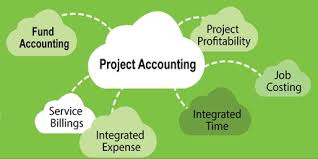Project Accounting
Project Accounting is a specialized form of accounting that tracks project delivery, helping track, report, and analyze financial results and implications.
Project accounting is a specialized form of accounting that corresponds to the ever-evolving needs of project delivery, which helps adequately track, report, and analyze financial results and implications. This includes the practice of creating compiled financial statements specifically designed to track the financial progress of projects, which can then be used by managers to aid project management.
Traditionally, project accounting and its principles were largely used to track and report predominantly large construction, engineering, and government projects. Today, project management delivery methodologies have expanded into several other sectors, including financial, technology, and legal. Subsequently, project accounting has needed to follow to cover these areas to ensure corresponding financial tracking and financial implications are understood and considered.
The need for project accounting arose as a specialized field from the nature of projects being treated as separate temporary individualized entities set up to deliver one or more business products. As the nature of each project may be different from the business-as-usual activities run by the business, existent management accounting and financial accounting skills were recognized as insufficient to accurately advise on the treatment and financial reporting of a project. Hence, a new field emerged within the accounting sphere – project accounting.
Project accounting therefore includes:
- A separate accounting system or cost center to track and report project specific transactions, with project revenues, costs, assets, and liabilities identified and allocated to the project.
- Frequent reporting, with the frequency, often increasing as the project approaches completion.
- A layer of simplified reporting, including key performance indicators relevant to whether the project is on or off track. For instance, traffic lights on a dashboard.
- A process for identifying project related transactions in the main accounting system and allocating or apportioning these to the project accounting system.
- Forecasting of costs to complete the project. Key stakeholders are often not only focused on the costs incurred to date but also those committed and the expected final cost.
Projects differ from the day-to-day business-as-usual activities in that they frequently cross organizational boundaries, may last for anything from a few days or weeks to several years, during which time budgets may also be revised many times. They may also be one of several projects that make up a larger overall project or program.
Consequently, in a project management environment costs (both direct and overhead) and revenues are also allocated to projects, which may be subdivided into a work breakdown structure, and grouped into project hierarchies. Project accounting permits reporting at any such level that has been defined and often allows comparison with historical as well as current budgets.
Project accounting is commonly used by government contractors, where the ability to account for costs by contract (and sometimes contract line item, or CLIN) is usually a requirement for interim payments.
Percentage-of-completion is frequently independently assessed by a project manager, program management officer (PMO), and project accountant. It includes the continuous recognition of revenues and income related to longer-term projects. By doing this, the seller can identify some gain or loss relevant to a project in every accounting period that is ongoing active. Funding advances and actual-to-budget cost variances are calculated using the project budget adjusted to percent-of-completion.
Where labor costs are a significant portion of the overall project cost, it is usually necessary for employees to fill out a timesheet to generate the data to allocate project costs.
The capital budget processes of corporations and governments are chiefly concerned with major investment projects that typically have upfront costs and longer-term benefits. Investment go/no-go decisions are largely based on net present value assessments. Project accounting of the costs and benefits can provide crucially important feedback on the quality of these important decisions.
An interesting, specialized form of project accounting is production accounting, which tracks the costs of the individual movie and television episode film production costs. A movie studio will employ production accounting to track the costs of its many separate projects.
Role of the Project Accountant
The project accountant requires knowledge of management accounting and financial accounting. They combine the complexities of cross-functional involvement, as well as project delivery frameworks and methodologies used by the business. Within a project delivery framework, the project accountant plays a dual role of:
- Gatekeeper reporting in to the business the true and fair view of how the project is tracking financially; and
- Advisor advising the project team as to the financial treatment and implications of the various decisions being made, their impact on both the project and the business.
The key benefit of this is the project accountant ultimately plays a Translator role between the project and other finance /accounting functions.
The role of a project accountant depends on the project needs, but as a basic function, the project accountant position is accountable for monitoring the progress of projects, investigating variances, approving expenses, and ensuring that project billings are issued to customers and payments collected.
In the U.S., a Project accounting accountant earns an average salary of $81,830 per year, with salaries ranging between $59,769 – $123,896. Most people working in this field move to a different position after approximately 20 years. The jobs that normally increase pay towards this job is Budget Managing and Cost Accounting. Experience has a moderate effect on income for this job.
Percentage of Completion Method
The percentage-of-completion method of Project accounting permits companies to record profits as development is made toward the finishing of the project. This method is not to be used when compelling uncertainties about the percentage of completion of the remaining costs to be incurred. The method instead works at its finest when it is rationally likely to estimate the stages of the project in process.
The percentage-of-completion may be measured in any of the resulting ways:
Cost-to-cost method: This is an example of the contract cost acquired to date the total expected cost. The price of the products already bought for a contract however have not yet been installed should not be added in the perseverance of the percentage of completion of a project, not unless they were particularly created for the contract. Also, assign the cost of equipment over the contract course, rather than direct, unless title to the supplies is being transported to the customer.
Efforts-expended method: This is the share of effort consumed to date in comparison to the total effort expected for the agreement. E.g. the percentage of completion may be established on direct work hours, machine hours, or material size.
Units-of-delivery-method: This is the portion of units delivered to the buyer to the overall number of units to be brought under the terms of a contract. It should only be in use when the builder produces several units to the requirements of a buyer. The recognition is established on:
- For revenue, the contract price of units delivered
- For expenses, the costs reasonably allocable to the units delivered
Project accounting necessary steps are the following:
- Subtract the total predicted contract costs from total approximated revenues to appear at the total estimated gross margin.
- Measure the range of process toward completion, using one of the methods mentioned above.
- Increase the total likely contract revenue by the estimated finishing percentage to arrive at the total amount of revenue that can be acknowledged.
- Subtract the contract revenue allowed to date through the foregoing period from the complete amount of revenue that is accepted. Recognize the development in the current accounting period.
- Consider the cost of the received revenue in the same manner. This means raising the same percentage of completion by the total supposed contract cost and subtracting the amount formerly realized to arrive at the cost of collected revenue to be recognized in the current accounting period.
Calculations
The following calculation is used to determine the completion percentage:
Percent Complete = Cost Incurred to Date / Total Cost Estimate
The current period revenue to be recognized during production would then be:
Current Period Revenue = (Percent Complete x Total Contract Revenue) – Revenue Recognized in Prior Periods
Production Accounting
Production Accounting involves the person who is essential in the film industry to manage the finances and financial records during the film production. Working in this position requires being in close association with the producer and the production office for the development of the film budget and to arrange schedules. Further into this role, as the accountant for a film, day-to-day duties are expected such as the normal accounting tasks of an office and maintaining the budget by recording the expenses accumulated to make secure they do not go over the allocated budget.
Other duties of the production accountant include:
- Managing the payroll
- Managing the petty cash
- Analyzing costs
- Provide weekly cash reports
- Estimating future costs
Project Accounting
Welcome to the Gutenberg Editor
The goal of this new editor is to make adding rich content to WordPress simple and enjoyable. This whole post is composed of pieces of content—somewhat similar to LEGO bricks—that you can move around and interact with. Move your cursor around and you’ll notice the different blocks light up with outlines and arrows. Press the
How to Increase Profit Margins Through Virtual CFO Services
How to Increase Profit Margins Through Virtual CFO Services

Great Accounting Firms Share These 10 Traits
Great Accounting Firms Share These 10 Traits which has gone far beyond the paper-pushing days and now involves acting as a virtual CFO

Tax Accountant in Miami Cope with IRS Tax Season Delay
Tax Accountant said IRS delays start of tax season for individual returns would be postponed until February 17 with some as late as March

Miami Accountants Philosophy of Up or Out
Its up or out for Miami Accountants firms are faced with the dilemma of keeping long-term managers that are not ready to be equity partners or let them go.

Contadores en Miami Explican Auditorías del IRS
Contadores en Miami, Gustavo A Viera CPA, explica los pasos de una auditoría, desde la notificación de la auditoría hasta el cierre de la misma
Home » Blog » Accountants in Miami » Project Accounting

